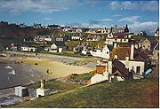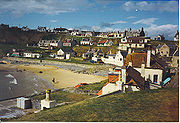
Collieston
Encyclopedia


North Sea
In the southwest, beyond the Straits of Dover, the North Sea becomes the English Channel connecting to the Atlantic Ocean. In the east, it connects to the Baltic Sea via the Skagerrak and Kattegat, narrow straits that separate Denmark from Norway and Sweden respectively...
coast in Aberdeenshire
Aberdeenshire
Aberdeenshire is one of the 32 unitary council areas in Scotland and a lieutenancy area.The present day Aberdeenshire council area does not include the City of Aberdeen, now a separate council area, from which its name derives. Together, the modern council area and the city formed historic...
, Scotland
Scotland
Scotland is a country that is part of the United Kingdom. Occupying the northern third of the island of Great Britain, it shares a border with England to the south and is bounded by the North Sea to the east, the Atlantic Ocean to the north and west, and the North Channel and Irish Sea to the...
. The village lies just north of the Sands of Forvie
Sands of Forvie
The Sands of Forvie is a nature reserve north of Newburgh in Aberdeenshire in the northeast of Scotland. Forvie National Nature Reserve has the fifth largest sand dune system in Britain, and the least disturbed by human activity. The dune system is an integral part of the Ythan Estuary and...
Special Protection Area
Special Protection Area
A Special Protection Area or SPA is a designation under the European Union Directive on the Conservation of Wild Birds.Under the Directive, Member States of the European Union have a duty to safeguard the habitats of migratory birds and certain particularly threatened birds.Together with Special...
, between Cruden Bay
Cruden Bay
Cruden Bay is a small village in Scotland, on the north coast of the Bay of Cruden in Aberdeenshire, 26 miles north of Aberdeen.Just south of Slains Castle, Cruden Bay was the site of a battle between Danes and Scots under King Malcolm II in 1012...
and Newburgh
Newburgh, Aberdeenshire
Newburgh is a coastal village in Aberdeenshire, Scotland. The village dates to 1261 AD, when Lord Sinclair wanted to establish a chapel in the area. Originally built as a school, somewhat later the chapel of Holy Rood was established.-Geography:...
.
History
The earliest recorded history of Collieston is of the arrival of St Ternan, a ColumbanColumbanus
Columbanus was an Irish missionary notable for founding a number of monasteries on the European continent from around 590 in the Frankish and Lombard kingdoms, most notably Luxeuil and Bobbio , and stands as an exemplar of Irish missionary activity in early medieval Europe.He spread among the...
monk
Monk
A monk is a person who practices religious asceticism, living either alone or with any number of monks, while always maintaining some degree of physical separation from those not sharing the same purpose...
on a mission to convert the local picts
Picts
The Picts were a group of Late Iron Age and Early Mediaeval people living in what is now eastern and northern Scotland. There is an association with the distribution of brochs, place names beginning 'Pit-', for instance Pitlochry, and Pictish stones. They are recorded from before the Roman conquest...
to Christianity
Christianity
Christianity is a monotheistic religion based on the life and teachings of Jesus as presented in canonical gospels and other New Testament writings...
. There is, however, evidence that people lived here during much earlier times.
Collieston was established as a fishing village by the 16th century, and it provides the first safe harbour in over fifteen miles of beaches and dunes stretching north from Aberdeen
Aberdeen
Aberdeen is Scotland's third most populous city, one of Scotland's 32 local government council areas and the United Kingdom's 25th most populous city, with an official population estimate of ....
. Fishing for herring
Herring
Herring is an oily fish of the genus Clupea, found in the shallow, temperate waters of the North Pacific and the North Atlantic oceans, including the Baltic Sea. Three species of Clupea are recognized. The main taxa, the Atlantic herring and the Pacific herring may each be divided into subspecies...
, haddock
Haddock
The haddock , also known as the offshore hake, is a marine fish distributed on both sides of the North Atlantic. Haddock is a popular food fish and is widely fished commercially....
, whiting
Merlangius merlangus
Merlangius merlangus, commonly known as whiting is an important food fish in the eastern North Atlantic, northern Mediterranean, western Baltic, and Black Sea...
and cod
Cod
Cod is the common name for genus Gadus, belonging to the family Gadidae, and is also used in the common name for various other fishes. Cod is a popular food with a mild flavor, low fat content and a dense, flaky white flesh. Cod livers are processed to make cod liver oil, an important source of...
flourished in the 17th century and 18th century and was the foundation of Collieston's economy. The village became known for 'Collieston Speldings', salted and sun-dried haddock and whiting, a popular delicacy throughout Britain
Early Modern Britain
Early modern Britain is the history of the island of Great Britain, roughly corresponding to the 16th, 17th, and 18th centuries. Major historical events in Early Modern British history include the English Renaissance, the English Reformation and Scottish Reformation, the English Civil War, the...
. As drift net
Drift net
Drift netting is a fishing technique where nets, called drift nets, are allowed to float freely at the surface of a sea or lake. Usually a drift net is a gill net with floats attached to a rope along the top of the net, and weights attached to another rope along the foot of the net to keep the net...
ting developed during the mid 19th century, the fishing began to decline and the focus of the industry shifted to places like Peterhead
Peterhead
Peterhead is a town in Aberdeenshire, Scotland. It is Aberdeenshire's biggest settlement , with a population of 17,947 at the 2001 Census and estimated to have fallen to 17,330 by 2006....
because the harbour at Collieston was too small to safely accommodate the larger boats needed.
The numerous sea cave
Cave
A cave or cavern is a natural underground space large enough for a human to enter. The term applies to natural cavities some part of which is in total darkness. The word cave also includes smaller spaces like rock shelters, sea caves, and grottos.Speleology is the science of exploration and study...
s in the nearby cliff
Cliff
In geography and geology, a cliff is a significant vertical, or near vertical, rock exposure. Cliffs are formed as erosion landforms due to the processes of erosion and weathering that produce them. Cliffs are common on coasts, in mountainous areas, escarpments and along rivers. Cliffs are usually...
s, and small coves with shingle beaches provided ideal terrain for smugglers
Smuggling
Smuggling is the clandestine transportation of goods or persons, such as out of a building, into a prison, or across an international border, in violation of applicable laws or other regulations.There are various motivations to smuggle...
. In the late 18th century it was estimated by the Excise
Excise
Excise tax in the United States is a indirect tax on listed items. Excise taxes can be and are made by federal, state and local governments and are far from uniform throughout the United States...
that up to 8000 gallons of foreign spirits
Distilled beverage
A distilled beverage, liquor, or spirit is an alcoholic beverage containing ethanol that is produced by distilling ethanol produced by means of fermenting grain, fruit, or vegetables...
were being illegally landed in the area every month. In 1798, the notorious village smuggler, Phillip Kennedy, was killed by a blow from an exciseman's cutlass
Cutlass
A cutlass is a short, broad sabre or slashing sword, with a straight or slightly curved blade sharpened on the cutting edge, and a hilt often featuring a solid cupped or basket shaped guard...
. His grave and tombstone still stands in the village graveyard
Cemetery
A cemetery is a place in which dead bodies and cremated remains are buried. The term "cemetery" implies that the land is specifically designated as a burying ground. Cemeteries in the Western world are where the final ceremonies of death are observed...
.
A ship from the Spanish Armada
Spanish Armada
This article refers to the Battle of Gravelines, for the modern navy of Spain, see Spanish NavyThe Spanish Armada was the Spanish fleet that sailed against England under the command of the Duke of Medina Sidonia in 1588, with the intention of overthrowing Elizabeth I of England to stop English...
, the Santa Caterina, carrying arms for the Earl of Erroll
Earl of Erroll
The Earl of Erroll is an ancient title in the Peerage of Scotland. It was created in 1453 for Sir William Hay.The subsidiary titles held by the Earl of Erroll are Lord Hay and Lord Slains , both in the Peerage of Scotland. The Earls of Erroll also hold the hereditary office of Lord High Constable...
is said to have sunk just off the rocky point of St Catherine's Dub in 1594. In retaliation for the Earl's involvement in the Catholic
Roman Catholic Church
The Catholic Church, also known as the Roman Catholic Church, is the world's largest Christian church, with over a billion members. Led by the Pope, it defines its mission as spreading the gospel of Jesus Christ, administering the sacraments and exercising charity...
plot against him, James VI
James I of England
James VI and I was King of Scots as James VI from 24 July 1567 and King of England and Ireland as James I from the union of the English and Scottish crowns on 24 March 1603...
blew up the Earl's castle which stood on the cliffs, a mile north of Collieston. The Earl went on to rebuild Slains Castle
Slains Castle
New Slains Castle is a ruined castle near Cruden Bay in Aberdeenshire, Scotland, overlooking the North Sea.The remains stand perched atop tall, sea-facing cliffs, constructed around an existing tower house built in 1597 by the 9th Earl of Erroll. Significant reconstruction of the castle has been...
, six miles further up the coast, in 1597.
Collieston is now mainly a commuter
Commuting
Commuting is regular travel between one's place of residence and place of work or full time study. It sometimes refers to any regular or often repeated traveling between locations when not work related.- History :...
village serving Aberdeen, and is largely given over to tourists
Tourism
Tourism is travel for recreational, leisure or business purposes. The World Tourism Organization defines tourists as people "traveling to and staying in places outside their usual environment for not more than one consecutive year for leisure, business and other purposes".Tourism has become a...
during the summer months.
Trivia
In September 1930, T. E. Lawrence, better known as Lawrence of ArabiaT. E. Lawrence
Lieutenant Colonel Thomas Edward Lawrence, CB, DSO , known professionally as T. E. Lawrence, was a British Army officer renowned especially for his liaison role during the Arab Revolt against Ottoman Turkish rule of 1916–18...
, rented a cottage in the village while on leave from the RAF
Royal Air Force
The Royal Air Force is the aerial warfare service branch of the British Armed Forces. Formed on 1 April 1918, it is the oldest independent air force in the world...
. He referred to the cottage in his writings as "the nearest hovel to the high-tide mark". This cottage still exists, although it has since been modernised and extensively rebuilt.

